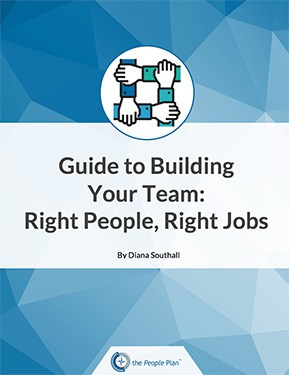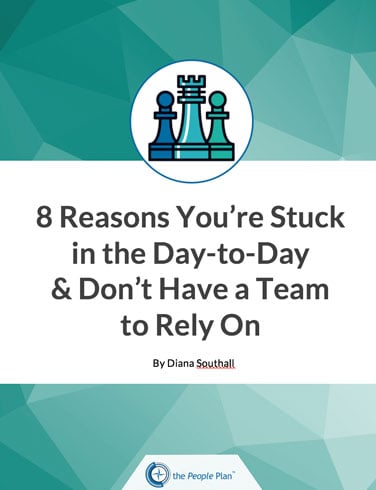
by thepeopleplan | Sep 30, 2013 | Uncategorized
As a small business manager, you might think that large employers have it “easier” to keep great employees. After all, the big guys can pay more, provide more job security and career advancement, and off better benefits.
Actually, I often see that despite the resources at large companies, the direct managers are not using those resources wisely and have the same issues with retaining their best and brightest.
Here is a list of what they might do, and you can too, to build your fabulous team.
What can your small organization offer that will help you keep your talented employees?
- Challenging work— many employers hire a new employee, train them, and then leave them doing a job that becomes routine and frankly, boring. Check in with employees regularly to find out what new assignments you can give to keep them challenged.
- Less hassles— a primary reason employees look for another job is a lack of resources to do the job and unreliable co-workers. Encourage your team members to identify hassles and road blocks and then work to eliminate as many as possible.
- Work and results tied to something meaningful—the term “second paycheck” was coined to indicate that meaningful work is also rewarding. I have a client that makes concrete products and their employees take pride in the fact that they are part of American manufacturing and their products are used to keep roads and bridges safer.
- Involvement in company decisions— employees want to be part of something bigger and feel good about their employer and its direction. Get input on major strategic goals and keep communicating about the why and where your organization is going.
- Everyone gets development opportunities— if an employee feels that she has a “dead end job” you definitely won’t get above and beyond work. We recommend that everyone has an annual development plan to work on 3-4 key training goals, such as improving a competency, technical skill or contributing to a major project.
As you can see from this list, the direct manager plays an important role in understanding each employee’s talents and needs, communicating how everyone contributes to the organization’s goals, and involving each person finding how they can match up their interests and goals with what the employer needs.
It’s hard to get your team on board and on the same page if you are hiding in your office— so get out there and talk more with your team.
Image courtesy of Stuart Miles at FreeDigitalPhotos.net

by thepeopleplan | Jul 17, 2013 | culture, performance
Our prior article What Drives Engagement? listed the top 10 engagement drivers.
Two areas impact employee perceptions of what the organization values (category 2):
#1. “(My boss) sets high personal standards”
- Share what excellence and success looks like in their job (do you have any key performance indicators to discuss/ share/ track?)
- Hold everyone accountable to do their job to expectations (including yourself- walk the walk)
#2. “Organization encourages innovative thinking”
- Listen to new ideas and process suggestions, thoughtfully consider and discuss the viability of the idea
Three steps you can take NOW to improve employee perceptions of work standards and innovation:
- Regularly discuss work load and priorities, find out if team members have the tools and information to complete their tasks, and invite updates to re-direct if things aren’t on track
- Manage by results, not micromanage the process—this allows your team member to come up with a different (and often better) way to achieve the same outcome, then occasionally have staff share their methods with others doing the same task
- Ask your team- “What is one thing that could be improved for better customer service or to reduce a big hassle?” Then outline an action plan, assign tasks with deadlines, and revisit at your weekly meeting to implement this innovative improvement
Two articles for more reading:
It’s a fine line between setting high standards and being demanding. Read what NOT to do on Forbes: 10 tips on for dealing with an overly demanding boss
For tips on getting more practice at innovative thinking and turning into a habit, read “Innovation Is Everyone’s Job” on Harvard Business Review
Image courtesy of Stuart Miles at FreeDigitalPhotos.net

by Diana Southall | Apr 23, 2013 | coaching, rewards
Our recent blog post showed that employees desire more appreciation and recognition, so here is a quick template for you to develop your own semi-formal recognition program.
(If you involve your team members in the development process, we will give you bonus points).
•List 3 ABC’s (ABC- attitudes, behaviors and contributions) that would improve your internal team work
•List 3 ABC’s that would improve your customer care
•List 3 ABC’s that support your organization’s core values
•Communicate list of 9 ABC’s to your employees (team meeting? poster on the wall?) and what you plan to do with it
•Make a list of when you can recognize at least one employee publicly for demonstrating one of these ABC’s
•Invite team members to recognize each other when they witness an ABC
•Take one minute to recognize an employee privately if you witness a great ABC
•Schedule and recognize based on your plan
Image courtesy of Maggie Smith at FreeDigitalPhotos.net

by thepeopleplan | Jul 13, 2012 | Uncategorized
Last month our blog discussed what is Culture and why does it matter.
Essentially Culture is the attitudes, belief sets, values, written ground rules, and unwritten ground rules that set the tone of the organization and the guidelines by which employees make decisions.
If you want to use the powerful force of Culture as a motivational tool, you have to identify the culture you want and that will support the organizational goals. The Alexander Group has identified what they call the “management compass” based on what an organization focuses on (see list below- basic types of cultures).
Steps to align Culture with Goals
- Decide what type of culture you have now and want — see short list below (basic types of cultures) to find yours
- Is there a gap between current and desired Culture? Do you need Culture change?
- Identify the organizational strategy and short-term goals
- Communicate Values and performance that will support the Culture and achieve the goals/ results
- Train and coach immediate supervisors to recognize behaviors that demonstrate desired performance, and to give corrective feedback when behaviors show a lack of commitment to the values or goals
- Reward those employees (financial and non-financial) that show a commitment to the values or goals
- Council employees who are not demonstrating the expected Values and/or Actions and explain consequences, then act on those consequences if there is not adequate improvement
- Continue steps 4-7 as long as the strategy and goals are similar (if the strategy changes dramatically and requires a new Culture (think Kodak) then go back to #1 to identify new desired Culture)
Basic types of cultures (what is valued):
- Results oriented
- Focus on shareholders
- Employee oriented
- Individualistic
- Customer focused
- The organization as an Institution
- Great at execution (achieving goals)
Image courtesy of David Castillo Dominici at FreeDigitalPhotos.net

by thepeopleplan | Apr 19, 2012 | Uncategorized
Let us take a moment to describe what Human Resources Management really is.
Most people think of the administrative side of “HR,” that department that handles payroll and benefits and record keeping. While important, HR administrative does not make you any money (actually costs you money to maintain) and does not help you improve your business or profits.
The strategic side of Human Resources Management is defining and using processes to make sure you have the Right employees, doing the Right things, and that they do them Right. Then we need to keep these Right People engaged and reward them! This concept is really what Performance Management is all about (so much more than an “annual review”)- managing employee performance for organization goal achievement.
What your managers should be doing:
- Explain performance expectations to each employee (and how they can support organizational goals)
- Get employee commitment to meet expectations
- Measure performance and share with employees
- Give feedback and coach employees to improve performance
- Recognize and reward good performance
- Build a culture and a team that works together to achieve organizational goals
What your organization needs to define and communicate:
- Overall organizational strategy, values, culture
- Specific goals by department and job
- Performance expectations for each job (tied to organizational goals)
- Measurements of performance by individual, team, department, entire organization
- HR systems to assist with recruiting, selection, training, management for employee success
- Total Rewards strategy that attracts, retains and engages top performers
- Manager coaching and resources to do all of the above
The above elements are what all large organizations have – but small organizations can have these as well with the People Plan™ . This is a four-phase process to identify your custom People strategy and then implement People systems to allow your organization achieve its goals. Contact us to receive our free white paper on the 9 steps to build a People Plan.
Image courtesy of basketman at FreeDigitalPhotos.net








